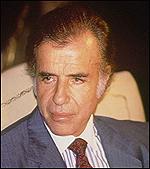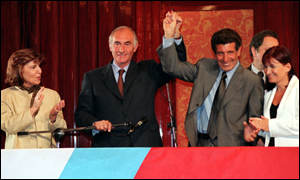CSPE Links
 Timor
Timor
 Cuba
Cuba
 Global Warming
Global Warming Africa I
Africa I  Argentina
Argentina  The Courts
The Courts  US Presidency
US Presidency  ASTI Strike
ASTI Strike  Attack
on America
Attack
on America
His second wife, the popular Eva Duarte de Peron (Evita) won the backing of trade unions; her popularity among the industrial working class was the major pillar of support for the Peron regime.

Throughout most of its history Argentina has suffered political instability and military coups. It belatedly entered (1945) World War II on the Allied side after four years of pro-Axis neutrality. Juan Peron, an army colonel who, with a group of colonels, seized power in 1944, won the elections of 1946 and established a popular dictatorship with the support of the army, nationalists, and the Roman Catholic Church.
His second wife, the popular Eva Duarte de Peron (Evita) won the backing of trade unions; her popularity among the industrial working class was the major pillar of support for the Peron regime. Her death in 1952, followed by an economic downturn, led to Peron being ousted from power (1955) by the military.
Government during the next 18 years had to contend with the continuing popularity of the Peronist movement. In 1973, Peron returned from exile and won election as president. His third wife, Isabel Martinez de Peron, was elected vice president; she succeeded him upon his death in 1974.
During her presidency terrorism by the left and right grew, and inflation worsened; in 1976 she was overthrown in a military coup that established a repressive military junta. In 1982, with Gen. Leopoldo Galtieri as president, Argentina occupied the Falkland Islands, which it had long disputed with Britain. The Argentine defeat in the ensuing war with Britain led to Galtieri's resignation and to strong public criticism of the military government.
 In the late 1980s, the government was unable to curb an annual inflation rate of more than 1000%, and in 1989, a Peronist, Carlos Saul Menem(right), was elected president. Menem reduced the government's regulation of the economy, privatized state-owned enterprises, and introduced austerity measures to control persistent inflation. He was re-elected in 1995.
In the late 1980s, the government was unable to curb an annual inflation rate of more than 1000%, and in 1989, a Peronist, Carlos Saul Menem(right), was elected president. Menem reduced the government's regulation of the economy, privatized state-owned enterprises, and introduced austerity measures to control persistent inflation. He was re-elected in 1995.This year a new President, Fernando de la Rua, was elected. He has promised to clean up the country after many years of corruption under the Menem regime. Mr Menem's presidential jet, Tango 01, purchased for $66 million, has been put up for sale. Mr De La Rua flies on commercial airlines, albeit in first class. Tango 01 carries 200 people and comes equipped with goldplated taps and a giant bed. Mr De La Rua (pictured below after his election victory) enjoys public support for now, but crime, hunger, declining salary levels and rising unemployment are urgent issues which will determine his long-term success.



Evita

Maradona

Juan Peron